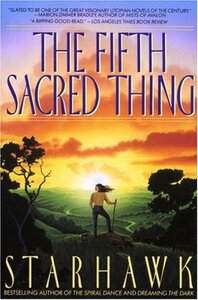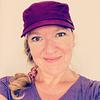Take a photo of a barcode or cover
adventurous
challenging
reflective
medium-paced
Plot or Character Driven:
Plot
Strong character development:
Yes
Loveable characters:
Yes
Diverse cast of characters:
Yes
Flaws of characters a main focus:
No
Right of the bat: this is a fairly flawed book, the first published fiction from a legend in the neopagan community. That said, I love the ideas underlying the story, and it still makes me tear up repeatedly while reading it.
---------------------------------------
I've learned recently that a scene where one character explains something to another, in order for the author to get that point across to the reader without having to work it into the exposition, is referred to as a "you know, Bob...", which I find hilarious. There's a really awful one here, early on - Maya says to Madrone, "did I ever tell you about XYZ?" Madrone: "Only about a million times." Maya: "Well, let me tell you one more time, then, in case you've forgotten." And then does. BWAHAHAHAHA!!!
---------------------------------------
I've learned recently that a scene where one character explains something to another, in order for the author to get that point across to the reader without having to work it into the exposition, is referred to as a "you know, Bob...", which I find hilarious. There's a really awful one here, early on - Maya says to Madrone, "did I ever tell you about XYZ?" Madrone: "Only about a million times." Maya: "Well, let me tell you one more time, then, in case you've forgotten." And then does. BWAHAHAHAHA!!!
It bogs down a bit with philosophy, but I expected that. It's a very different take on dystopia, interesting, but a bit long. An abridged version that focuses on the action would be fantastic.
What an astonishingly relevant book. Several decades into the future, and the consequences of climate change, corporate power, racism and other modern day societal ills have manifested into our worst fears. Yet this book is delivered from the perspective of those who do it right, from a place of love, community, acceptance and fairness. The story is gripping.
I highly recommend this book.
I highly recommend this book.
Just reread for the 20th anniversary...movie is in the works.
HIGHLIGHTS
~Hopepunk + witchcraft = The Best
~peace is violence’s kryptonite
~bees are a girl’s best friend
~everyone is named John and everything is F I N E
~a utopia you’ll believe in
~‘we didn’t destroy the databanks, the crystals just don’t like you’
The Fifth Sacred Thing is a book I don’t know how to talk about.
It’s not one of the books I instantly recommend the moment I make a new friend. It’s not even a book I gift to fellow fantasy-readers. It’s a book I’m shy of showing to people. It feels so private, so personal, so intimate. To put The Fifth Sacred Thing into someone else’s hands is like giving them my warm, beating heart to hold.
Considering what the eponymous fifth sacred thing of the main characters’ philosophy is – spirit, or love – that seems entirely appropriate.
This is a book set after a climate and societal collapse. In the North – of what used to be California, if I put the pieces together correctly – a new and painfully perfect society has been built, where people of all races and creeds have come together in their determination to find a better way. It’s a city where every child speaks American Sign Language, where shrines to Yemaya and Kuan Yin and the Virgin Mary are equally honoured, where there is no violence and no hunger or thirst. It’s a city built by witches, where computers are powered by semi-sentient crystals and healers use as much magic as medicine to treat their patients. It’s a city that holds four things sacred – earth, air, fire, and water – and whose philosophy is based upon the truth that no one can own these things, and no one can be denied them.
It sounds too good to be true, doesn’t it? The whole point of this book, though, is that it’s not. Is that it can be true.
It’s never going to be easy.
But it will always be worth it.
The Fifth Sacred Thing is a little bit of a manifesto, a little bit of an open question – and wholly an incredible story. We have three main characters: Maya, an elderly queer Jewish witch who was instrumental in the City’s creation; Bird, her biracial grandson; and Madrone, an immensely talented Latina witch-healer who is the grandchild of two of Maya’s lovers. Bird has been missing for ten years, after going south to scout out the lands of the Stewards – think Handmaid’s Tale, but turn the racism dial to 12 and add the worst perversion of Christianity you can imagine – and Madrone has spent about that long battling wave after wave of epidemics, which she and the other healers think might be an attempt at biological warfare from the Stewards.
The book opens during one such epidemic, and with Bird finally making his way home. What he has to tell his people is horrifying – the reality of life under the Stewards – and terrifying: the Stewards are definitely coming for the north.
How does a community built on peace defend itself against one built on violence?
Read the rest at Every Book a Doorway!
~Hopepunk + witchcraft = The Best
~peace is violence’s kryptonite
~bees are a girl’s best friend
~everyone is named John and everything is F I N E
~a utopia you’ll believe in
~‘we didn’t destroy the databanks, the crystals just don’t like you’
The Fifth Sacred Thing is a book I don’t know how to talk about.
It’s not one of the books I instantly recommend the moment I make a new friend. It’s not even a book I gift to fellow fantasy-readers. It’s a book I’m shy of showing to people. It feels so private, so personal, so intimate. To put The Fifth Sacred Thing into someone else’s hands is like giving them my warm, beating heart to hold.
Considering what the eponymous fifth sacred thing of the main characters’ philosophy is – spirit, or love – that seems entirely appropriate.
This is a book set after a climate and societal collapse. In the North – of what used to be California, if I put the pieces together correctly – a new and painfully perfect society has been built, where people of all races and creeds have come together in their determination to find a better way. It’s a city where every child speaks American Sign Language, where shrines to Yemaya and Kuan Yin and the Virgin Mary are equally honoured, where there is no violence and no hunger or thirst. It’s a city built by witches, where computers are powered by semi-sentient crystals and healers use as much magic as medicine to treat their patients. It’s a city that holds four things sacred – earth, air, fire, and water – and whose philosophy is based upon the truth that no one can own these things, and no one can be denied them.
It sounds too good to be true, doesn’t it? The whole point of this book, though, is that it’s not. Is that it can be true.
It’s never going to be easy.
But it will always be worth it.
The Fifth Sacred Thing is a little bit of a manifesto, a little bit of an open question – and wholly an incredible story. We have three main characters: Maya, an elderly queer Jewish witch who was instrumental in the City’s creation; Bird, her biracial grandson; and Madrone, an immensely talented Latina witch-healer who is the grandchild of two of Maya’s lovers. Bird has been missing for ten years, after going south to scout out the lands of the Stewards – think Handmaid’s Tale, but turn the racism dial to 12 and add the worst perversion of Christianity you can imagine – and Madrone has spent about that long battling wave after wave of epidemics, which she and the other healers think might be an attempt at biological warfare from the Stewards.
The book opens during one such epidemic, and with Bird finally making his way home. What he has to tell his people is horrifying – the reality of life under the Stewards – and terrifying: the Stewards are definitely coming for the north.
How does a community built on peace defend itself against one built on violence?
Read the rest at Every Book a Doorway!
Dystopian fiction. Feminist spirituality. Ecological concerns. This novel checks all my areas of interests, but it took a while to get into it. Maybe because there were so many characters in the beginning, it was hard to keep all the names straight. The narrative definitely picked up about a quarter of the way in, but still, I think Starhawk has more of a gift for nonfiction. I’m a fan and I really enjoyed living in this futuristic San Francisco for a while, but it wasn’t the most fast-paced story. However, the devolution of our global society described here seems eerily possible. And if you’re wondering, the five sacred things are: earth, air, water, fire, and SPIRIT. Honor them all with love. Namaste.
utopia/dystopia/armageddon/new age revolution. Gave me visions for years, and then I re-read it. So good. She also lives near my town. Yup.



